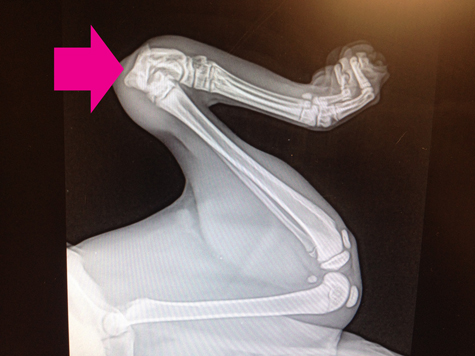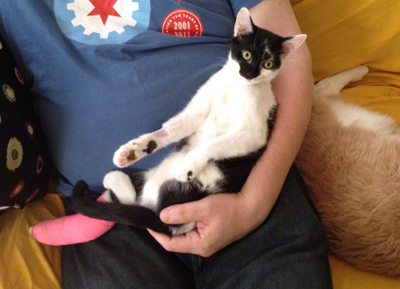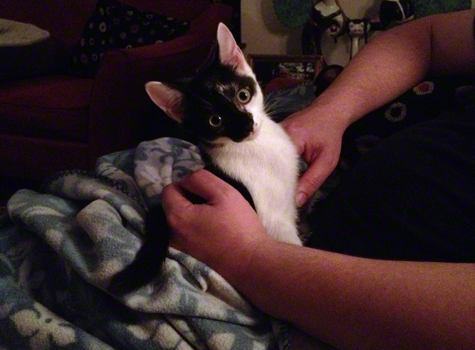
You are here
9 Ways to Prepare for an Emergency with your Cat
It’s late at night. I heard one of my foster kittens scream. Within seconds I was in the room with her and her family, my heart about to explode out of my chest I was so terrified. One by one I checked the kittens to see which one had been injured. Sure enough Twinkle-Twinkle looked up at me, took a step and literally fell over. Her back leg was broken. It was 11 PM. What should I do?
In the past month my cat rescue, Kitten Associates has had to deal with four emergencies. Some times these things happen even in the best home with the most loving care. I know what to do when trouble strikes, but do YOU KNOW what you’d do if your kitty suddenly became ill or was injured?

©2014 Robin A.F. Olson. Little bone broken. Big expense to repair it.
Here are some simple things you can do RIGHT NOW so you’re prepared for how to handle an emergency with your cat.
1. Get a Vet! If you don’t have a Vet, you SHOULD get out there and find one. They will maintain your cat’s health records. You’ll need this information sent to your ER Vet if your cat requires treatment where you have time to access those records. If you can, keep a copy of all your cat’s medial records in a place that’s easy to find so you can grab them and go. Remember, if you bring your cat in for a wellness exam annually you can avoid many problems that require a trip to the ER Vet in the first place.
2. KNOW THE DIFFERENCE between the ER Vet and your General Practitioner Vet. Usually the ER Vets are staffed with specialists in many areas of health, while your GP handles a wide range of issues, but usually does not have the suite of expensive equipment that an ER Vet would have or the experience to handle more difficult cases. Some times your GP vet can do the basic diagnostics then will refer you to an ER Vets.
ER Vets are open 24/7/365. Your GP won’t usually have those hours. If you think you’re cat will require overnight care, head to the ER. If you’re not sure where to go and you have time, call your GP Vet and ask them. For complicated cases they will often direct you to the ER Vet.

©2014 Robin A.F. Olson. Twinks in her boo-boo bandage.
3. Locate the 3 closest Emergency Vets and put their contact information in your address book, on your phone, everywhere you keep such information. If you can, choose to “Favorite” or add to speed-dial those vets, all the better. Don’t forget to enter the address of these vets into the GPS in your car. When you’re in a panic, the last thing you need to do is worry about how to get somewhere.
4. Have a cat carrier in an easy-to-access location. I use a big cat carrier with a heated pad inside it as a cat bed to reduce my cat’s fear of being in a cat carrier. It’s out all the time. Make sure your cat carrier is big enough to handle your cat since some people adopt a kitten, then never get a bigger carrier as the cat ages. Also, make sure your cat carrier isn’t falling apart. Some have plastic tab closures, or nuts that come loose. You want to be able to grab and go!
5. When an emergency occurs, first thing you do is CALL THE VET. Let them know you’re coming and what is happening with your cat so they can prepare and get staff ready for your arrival. Be prepared to as CLEARLY AS POSSIBLE describe the age, sex, breed of cat. Is your cat spayed/neutered? Is your cat up to date on vaccinations? Does she have any behavioral issues that might make treating her difficult? Be ready to describe why you think you’re cat is in crisis. The more information you can give them, the better they can prepare for your arrival.
This is also WHY you need more than one ER Vet’s contact information. The ER Vet you first call may tell you they are very busy or the specialist you might need is not on call that night so you can quickly call another ER Vet and make sure they can handle your cat’s care.
6. Other things to bring with you. Many times you’ll have to wait a long time before you can see a Vet if the ER is busy. Bring your phone charger. If you have a device where you can get online-like a tablet computer or laptop, bring it. You may be able to look up the diagnosis you get from the Vet so you can make better decisions.
7. MONEY! ER Vets want money UP FRONT once they determine what it will take to help your cat. Some vets charge more AFTER midnight. All are expensive-far more costly than your regular vet. If money might be an issue, apply to get CareCredit. It takes about 15 minutes to get approved, then you have the card if you need help. If you can pay off the charge in less than 6 to 24 months, it’s fee free. Your bill also has to be over $200.00 minimum.
Get health insurance for your cat NOW before she is 10 years old. That can help offset costs of care.
Lastly if you can get the ER Vet to give you time, you can opt to do an online fundraiser or reach out to family and friends. There are organizations that help cover costs of emergency medical expenses for people who get Public Assistance. Feline Veterinary Emergency Assistance is just one and they may be able to direct you to others. You can also find them on Facebook.
8. Try to BREATHE and stay calm. Being panicked means you're not thinking clearly. You're going to feel stressed and possibly upset. That's understandable, but focus on your cat. SHE NEEDS YOU to be as calm and focused as possible. Once you’re at the Vet they will take over so your cat will be safe. They may tell you things you don’t understand. Speak up! Ask questions. Ask if they can keep your cat stable until your regular Vet is opens if costs are an issue. There are certain situations where a GP Vet can take care of your cat, but if they don’t have late hours or staff caring for the animals at night it may not be an option.
9. Go over the line-item estimate carefully. Make sure you understand WHY you’re getting charged for each service if you don’t understand it. There may be other ways to handle the situation. As long as the staff understands that money is an issue they will usually adjust the estimate to the basics if that’s what you can manage. There are items like e-collars or other items you can provide to save on costs so ASK where you can help out. Some times you can provide some of the care at home and bring your cat in for an additional exam instead of paying a boarding fee.
I’m glad to report that today Twinkle got her cast off after having surgery to put 2 tiny pins into her heel bone. She’s comfortable and happy and I finally got my pulse to slow down. When you’re in the worst of it, remember, this will pass. You will get through it and hopefully because you’re done your homework, your cat will have the best chance possible to survive this challenging time.

©2014 Robin A.F. Olson. Snuggle time!
==================================
This post is sponsored by BlogPaws. I am being compensated for helping spread the word about #PetBloggerMonth, but Covered in Cat Hair only shares information we feel is relevant to our readers. BlogPaws is not responsible for the content of this article.


















Comments
Great information
Robin,
This is a great post with information every pet owner needs.
RE: EMERGENCIES
Thanks for the very educational and relevant suggestions! and the link to CareCredit.
SO GLAD little Twinkle is hopefully on the way back to complete health!
Excellent post!
Thank you for this, Robin!
Add new comment